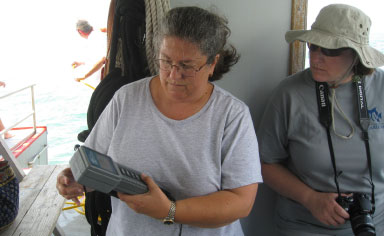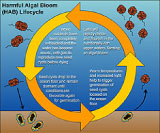|
|
|
Click this image to investigate Harmful Algal Blooms in the Gulf of Mexico |
|
Dr. Thomas's Gulf of Mexico research partners include Dan Kamykowski, John Morrison, and Jerry Janowitz, focusing on Harmful Algal Blooms
(HABs) in the northern Gulf of Mexico. Using a variety of laboratory experiments and computer modeling, a hypothesis on dinoflagellate
habitat was developed.
Carrie's role in the project has been to characterize nutrient concentrations in the very top of the sediment where
cells may be migrating into the sand and coral rubble. She also measures fluxes of key nutrients out of the sediment. "Primarily we want
to know if there are enough nutrients there at the sediment/water interface to keep these critters happy," she says, "and is the sediment
structure the right grain size and porosity to provide harbor." As a preliminary observation, the presence of benthic algae on the sea floor
seems to be connected to the appearance of HABs.
In 2008 Carrie participated in a cruise to capture the onset of a
Karenia dinoflagellate bloom, in order to learn more about where these
cells reside and what triggers them to come to the surface. "The algae moved inland right after our cruise," says Carrie. "We're pretty excited by
the preliminary data." Testing the hypothesis in the field, the team specifically chose the northwest Florida shelf between Pensacola and Panama City,
a location where HABs of
Karenia often occur yet is far enough away from the Mississippi delta. "Although we can see the freshwater lens...where
we are working, we are pretty well east of those major effects," says Carrie.
The team, having completed three cruises on the shelf, verified that
Karenia does aggregate near bottom. "We think that we have the circumstantial evidence that the near-bottom may act as a seed population, "she
says. "If there are upwelling favorable winds, the populations that are distributed over a broad area of the shelf would then be swept inshore and
the cells then aggregate at coastal fronts."




